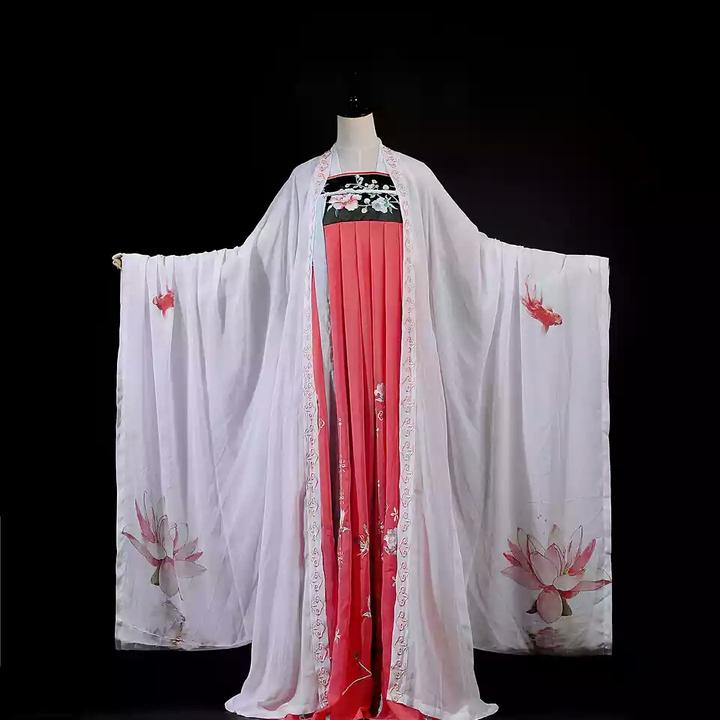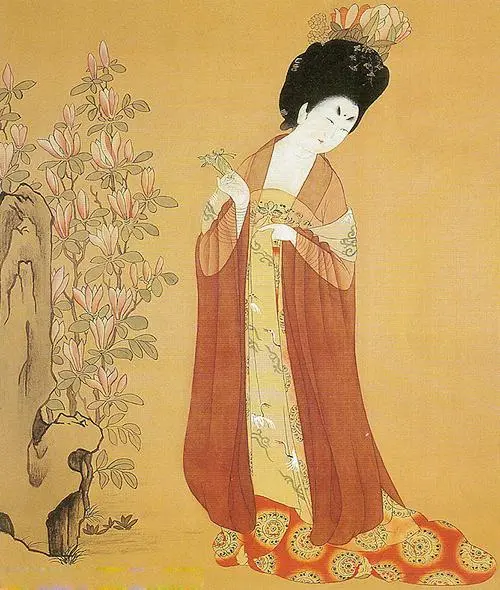The Large-sleeved shirt, known as "Da Xiu Shan" in Chinese, was a prominent aristocratic attire during the mid to late Tang Dynasty. This garment is often associated with the famous painting "Court Ladies Wearing Flowered Headdresses" by Zhou Fang, which vividly depicts noblewomen adorned in ankle-length skirts paired with sheer, large-sleeved gauze shirts that delicately cover their shoulders and arms. The artist's realistic portrayal not only captures the transparency of Tang fabrics but also the softness of the women's skin. This style persisted until the late Ming Dynasty, often paired with a ceremonial cape, and was alternatively called "Da Xiu" or "Da Shan."

During the High Tang period, the influence of Hu (nomadic) clothing waned, and women's fashion gradually embraced wider sleeves. By the mid to late Tang era, sleeves often exceeded four feet in width. The attire typically included a wide-sleeved cross-collared shirt, long skirt, and a draped shawl, reserved for significant occasions like court appearances, ceremonies, and weddings. Adorned with golden hairpins and floral decorations, it was also referred to as "Floral Hairpin Large-Sleeved Shirt."
Zhou Fang's painting, now housed in the Liaoning Provincial Museum, illustrates noblewomen leisurely strolling through gardens, picking flowers, and playing with butterflies. Their attire—transparent gauze dresses and towering floral headdresses—reflects the era's opulent fashion. Excavated pottery figurines from the mid to late Tang period confirm the accuracy of these depictions, showcasing the era's distinctive female fashion culture.
The Tang Dynasty's clothing culture mirrored its prosperous and open society. Poetry, like Bai Juyi's "Liao Ling," celebrated the luxurious fabrics and intricate designs of late Tang attire. Even today, some East Asian countries refer to certain formal dresses as "Tang" styles, highlighting its lasting influence.
Despite Confucian norms dictating gender-specific attire, Tang women often wore men's clothing—boots, robes, and hats—regardless of social status. This trend, influenced by foreign cultures, is documented in historical texts like "Old Book of Tang" and "New Book of Tang." Emperor Wenzong's 828 decree urging princesses to abandon short, narrow Hu-style clothing in favor of traditional Chinese attire marked a shift toward looser, more elaborate women's fashion. By then, skirts and sleeves had doubled in size, and sheer gauze shirts became a bold statement of femininity.
A hallmark of Tang fashion was the use of sheer silk gauze, often worn without undergarments, as seen in Dunhuang murals. This daring style, summarized by the phrase "silken threads reveal the skin," reflected the era's liberal ethos. The Tang Dynasty's vibrant clothing culture owed much to the Sui Dynasty's advancements in silk production. Tang textiles, renowned for their quality and variety, laid the foundation for the era's dazzling fashion, which blended domestic and foreign influences into a unique, exuberant style that continues to captivate modern audiences.

